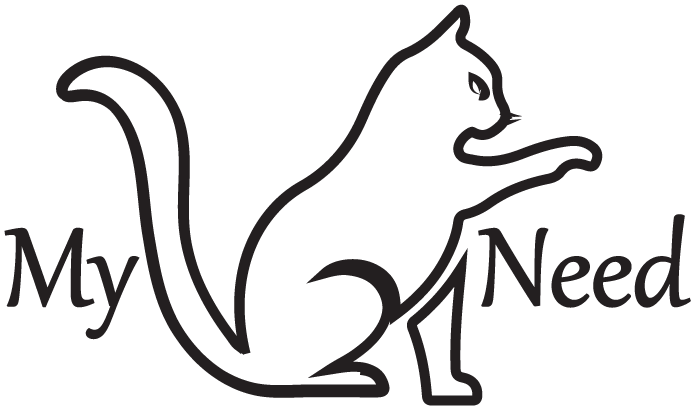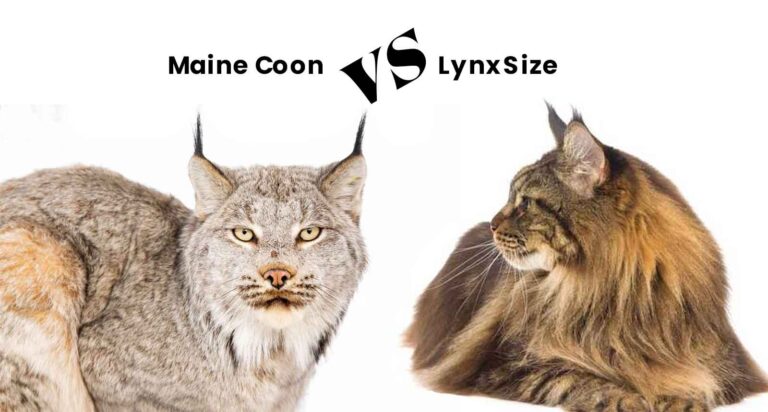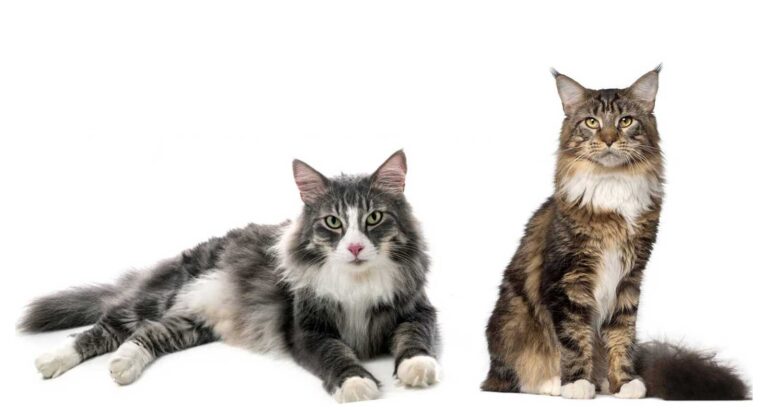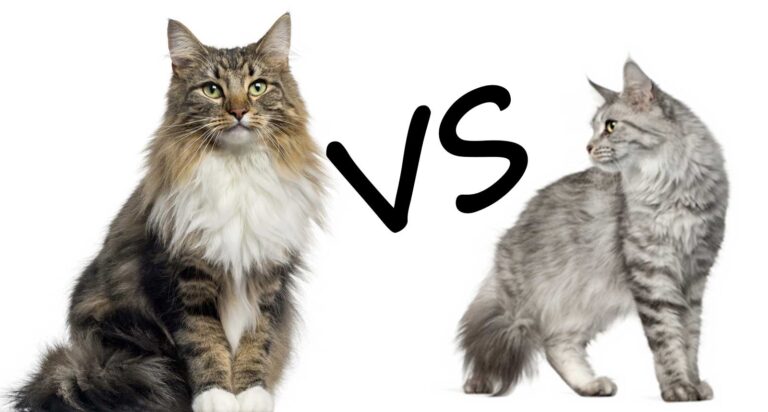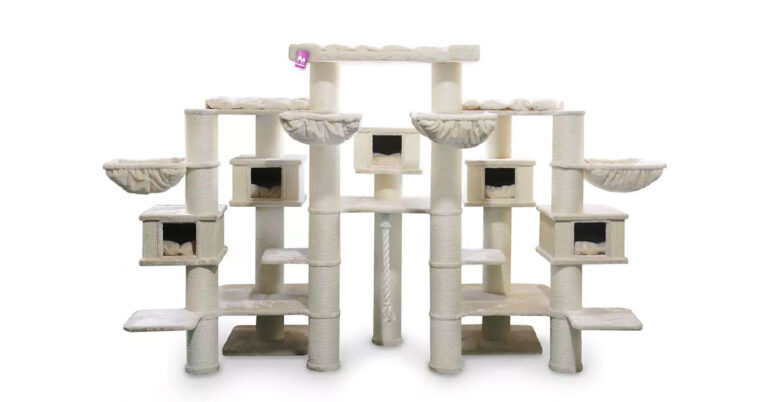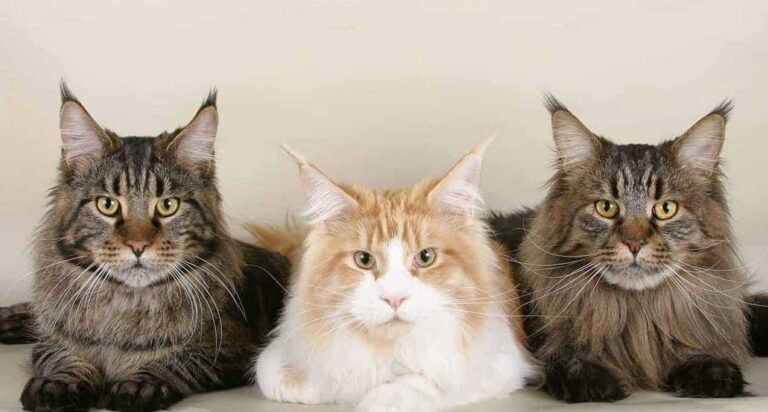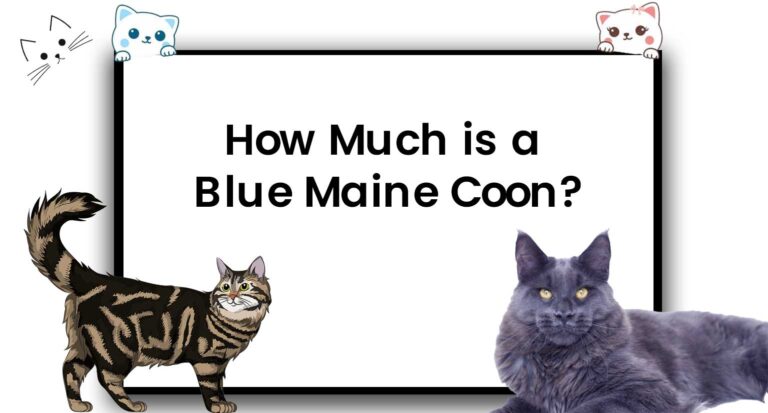Bobcat vs Maine Coon: Unveiling 8 Exciting Differences for Pet Enthusiasts
Welcome to the captivating world of feline companionship, we’re setting the stage for a unique face-off: Bobcat vs Maine Coon. An unbelievably diverse spectrum of breeds awaits the cat enthusiast, each exuding their own distinctive charm.
However, our spotlight today falls on two exceptional types—the wild, enigmatic bobcat and the majestic, domesticated Maine Coon cat. An initial glimpse might lead you to believe these two share no common ground, but prepare for a surprise.
Both breeds hail from the North American terrain and captivate us with their impressive physical characteristics and striking personalities. But, let’s put any fantasies of a bobcat purring on your lap over morning coffee aside.
We’re here to dissect the contrasts and parallels between these two intriguing felines, encompassing their origins, physical attributes, personality traits, and care requirements.
So, whether you’re a seasoned cat aficionado aiming to broaden your knowledge or in search for a new furry companion, join us on this journey as we unfold the compelling comparison between the untamed bobcat and the lovable giant, Maine Coon cat.
Bobcats vs Maine Coon Cats:
What’s the Difference?
When it comes to cats, the options are endless. From the elegant Siamese and the exotic Bengal, to the charming Ragdolls and the majestic Norwegian Forest cats, there are countless furry feline companions waiting to capture your heart.
Among the many breeds, two often-discussed favorites are the bobcat and the Maine Coon cat. So, what distinguishes these two breeds? Let us explore a comprehensive comparison to unveil their distinct characteristics and exceptional qualities!
Origins
The bobcat is a medium-sized wildcat native to North America, while the Maine Coon is a domestic breed that was developed in New England.
The Maine Coon originated from an accidental mating between raccoons and domesticated cats, resulting in its unique size and impressive fur coat.
Physical Attributes
Bobcats are known for their bobbed tails, giving them their name. They typically weigh between four and five kilos and they have brown or greyish coats with white markings on the chest, neck, or belly area.
On the other hand, Maine Coon cats are much larger in size and can weigh up to 10 kilos. They have large heads with wide-set ears, and their coats come in a variety of colors from solid black or white to tabby patterns.
Personality Traits
When it comes to personality, bobcats tend to be more skittish than domesticated cats. They are solitary creatures and they tend to be shy around humans.
Maine Coon cats, on the other hand, are known for their friendly nature and intelligence. They make great family pets as they enjoy being around people and generally have an easy-going approach to life.
Care Requirements
Bobcats require a significant amount of space and the right kind of environment to be able to thrive, so they are not suitable pets for most people.
In contrast, Maine Coon cats need a moderate amount of care and attention. They require regular grooming such as brushing their coats, as well as access to fresh food and plenty of exercise.
Physical Characteristics
In terms of physical characteristics, the bobcat and Maine Coon differ significantly. Bobcats, with their medium size, usually stand 20-24 inches at the shoulder and weigh between 13-30 pounds.
Their legs are long and powerful, with large, sharp-clawed paws, ideal for hunting. The fur coat of a bobcat is typically brown or grey, adorned with spots or stripes, and their distinguishing feature is their black-tipped, bobbed tail.
Maine Coons, on the other hand, are one of the largest domesticated breeds, with males reaching up to 18 pounds and females usually weighing between 8-12 pounds. They exhibit a variety of coat colors and patterns, including solid, tabby, and tortoiseshell.
Their fur coat is dense and water-repellent, which comes in handy in cold weather. Maine Coons also feature long tufted ears and bushy tails, which can be as long as 14 inches.
Their body is rectangular, and they have a broad chest and long legs, with large, rounded paws. Despite their size, their appearance is well-balanced and proportionate.
Size and Weight
Bobcats and Maine Coons have quite a difference in terms of size and weight. Bobcats, being wild animals, are generally larger and heavier than Maine Coons.
On average, an adult male bobcat can weigh anywhere between 16 to 31 pounds, while the females usually weigh between 10 to 16 pounds. They are approximately 30 to 50 inches long, which includes a 5-inch tail.
Maine Coons, considered as one of the largest domesticated cat breeds, have an average weight of 13 to 18 pounds for males and 8 to 12 pounds for females.
They can reach a length of 40 inches, including their fluffy tail which alone can measure up to 14 inches. Despite their large size, Maine Coons are well-proportioned and elegant, adding to their majestic appearance.
Appearance
Bobcats have a unique coloring that sets them apart from other cats. They typically have a gray-brown fur with lighter strips on the face, neck and chest.
Their coat is often adorned with spots or stripes, and their distinguishing feature is their black-tipped, bobbed tail.
Maine Coons are incredibly beautiful cats, boasting of a unique and striking appearance. Their fur is long, silky and feathery, coming in a range of colors such as white, red, black, silver, blue, cream,, Maine Coons also have amazing facial features such as wide-set eyes and a large muzzle.
Differences in appearance between the bobcat and a Maine Coon are striking and unique. Bobcats are wild animals, known for their muscular bodies and short hair. Their fur is typically a sandy or yellowish-brown, but can also be reddish-brown or gray. They possess distinctive black-tipped
ears and a stubby “bobbed” tail, from which they derive their name. Bobcats also feature a ruff of fur along the sides of their face, giving the appearance of sideburns.
Maine Coons, while being domestic cats, carry a wild, rugged look. They have a large, muscular body but are adorned with a shaggy, water-resistant coat that can come in nearly any color or pattern.
Their ears are wide-set and feature tufts of hair at the tips, resembling that of a lynx. Perhaps the most impressive feature is their long, bushy tail, often compared to a raccoon’s tail. They have high cheekbones and large, expressive eyes that can be of any color, further enhancing their striking appearance.
Fur and Coat
The fur and coat of the bobcat and the Maine Coon cat are distinct and reflect their adaptability to their respective environments.
Bobcats, being wild animals, have a dense double coat that is well-suited to their outdoor, often harsh, environments. The underfur is soft, dense, and insulating, keeping them warm in cold weather, while the outer fur is coarser and protects them from the elements.
Their fur also provides excellent camouflage, allowing them to blend seamlessly into their surroundings.
On the other hand, Maine Coons have a glossy and heavy coat that is shorter on the shoulders and longer on the stomach and flanks, with some having a lion-like ruff around their neck.
This combination of fur length allows them to survive in various climates. The coat is designed to withstand water, and hence, Maine Coons do not mind getting wet.
In fact, they often show an affinity for water, which is quite unusual for cats. Their coat requires regular brushing to prevent matting and tangling and to maintain its beautiful, shiny appearance.
Distinctive Features
Both the bobcat and the Maine Coon cat possess unique features that set them apart. The bobcat, for instance, is easily recognized by its tufted ears and stubby “bobbed” tail, which inspired its name.
Additionally, bobcats have well-developed, muscular bodies with hind legs that are longer than their front legs. This physical arrangement allows them to effortlessly scale trees and execute impressive leaps, essential skills in their natural habitat.
Maine Coons, in contrast, have an imposing presence due to their size. They are one of the largest domesticated breeds of cats.
They have a rectangular body shape, a strong bone structure, and a broad chest that contributes to their robust appearance.
Their most notable feature is their large, tufted ears – a trait they share with bobcats. These tufts are believed to have served as a form of protection from harsh weather.
Their big round eyes, which can be of any color, and their long, bushy tail, similar to a raccoon’s, are also significant characteristics of Maine Coons.
Behavior and Temperament
The bobcat is a solitary and reclusive creature, wary of human contact. While they can be tamed to some extent, these cats are not suitable pets due to their strong hunting instinct.
On the other hand, Maine Coons make affectionate and devoted companions. They develop deep bonds with their owners and enjoy being around people. Maine Coons are also known for their intelligence and playfulness, making them ideal family pets.
Although both cats are independent by nature, Maine Coons tend to be more social than bobcats and can even learn to live in harmony with other animals, including dogs. Bobcats remain solitary and territorial creatures, preferring the company of their own kind.
When it comes to character traits, Maine Coons tend to be more cuddly and outgoing, while bobcats can be aloof and distant.
Maine Coons, on the other hand, are known for their friendly and affectionate personality. Despite their daunting size, they are often referred to as “gentle giants”.
They are sociable and enjoy interacting with humans and other pets. Unlike bobcats, they don’t possess the same wild instincts.
They are more comfortable in a domestic setup and are quite trainable, adjusting well to their home environment. Regular mental and physical stimulation is necessary for them, interactive toys and games being a great way to keep them engaged.
Contrary to the solitary nature of the bobcat, Maine Coons enjoy company and do not like being left alone for extended periods.
In the Wild
In the wild, both the bobcat and the Maine Coon have their unique strengths and adaptations. Bobcats are indigenous to North America and are perfectly adapted to survive in the wild.
They are excellent climbers and swimmers, which gives them an edge while hunting prey. They boast of sharp retractable claws and a keen sense of hearing and sight, making them skilled hunters. Living in varied habitats ranging from forests, swamps, to semi-deserts, they showcase remarkable adaptability.
Maine Coons, although now domesticated, also exhibit certain wild traits owing to their likely origin from the Norwegian Forest Cat.
Their thick fur coat, intended to withstand harsh cold climates, and tufted ears and paws for insulation, are testament to their survival instincts.
However, in stark contrast to the bobcat, Maine Coons have adapted well to domestic living, lacking the wild instincts that make bobcats unsuitable for a home environment. While they can hold their own outdoors, they equally cherish the warmth and safety of a loving home.
With Humans
The interaction between humans and these two breeds of cat is vastly different. Bobcats, being wild animals, don’t typically interact well with humans.
They prefer to maintain their distance, viewing humans as potential threats. Therefore, owning a bobcat as a pet is not recommended and is even illegal in many jurisdictions.
On the other hand, the Maine Coon is a domestic cat breed that is often referred to as “the gentle giant”. They are known for their friendly, sociable, and affectionate nature, making them great companions for humans.
They’re very intelligent and curious, and they love to play with their human companions. They’re also patient and adaptable, making them a great choice for families with children and other pets.
The Maine Coon’s loving nature, coupled with their striking looks, make them a popular choice as a pet and they’re often seen in cat shows around the world.
Health and Lifespan
The “gentle giant” Maine Coon and the wild Bobcat, despite being felines, have notably different health concerns and lifespans. Owning a Maine Coon comes with responsibilities like monitoring their health for common issues such as hip dysplasia, muscular atrophy, and hypertrophic cardiomyopathy.
The Maine Coon’s impressive growth rate, with kittens not reaching full maturity until around 3-5 years, also means owners should be vigilant about their diet and exercise.
Common Health Issues
Bobcats, being wild animals, face a whole different set of health concerns compared to domesticated Maine Coons.
They are prone to diseases found in the wild, and their illegal status as pets makes it difficult to provide them with proper veterinary care.
Maine Coons, while generally healthy, can be predisposed to certain genetic conditions. These include hip dysplasia, which affects their mobility, and hypertrophic cardiomyopathy, a common heart disease in cats.
Life Expectancy
The lifespan of a bobcat in the wild ranges between 10-12 years, subject to numerous external factors. On the other end of the spectrum, a well-cared-for Maine Coon cat has a life expectancy of approximately 12-15 years, sometimes even longer.
Their longer lifespan is another reason why the Maine Coon makes for an excellent family pet, promising many years of companionship and love.
Habitat and Prey
The Maine Coon and the bobcat display distinct disparities in their habitat and prey preferences, reflecting their respective origins as domestic and wild animals..
Maine Coons have adapted well to various habitats and climates, from comfortable suburban homes to urban apartments. Bobcats, on the other hand, are innately wild and find their home in various natural habitats across North America.
Natural Habitat
Maine Coons are domestic cats and their natural habitat tends to be wherever their human family resides. They are remarkably adaptable and can thrive in various climates, owing to their thick fur that offers protection against cold climates.
Originating from the cold northeastern United States, the Maine Coon is thought to have descended from cats that traveled from Europe to North America via the Bering Land Bridge.
Contrarily, Bobcats are wildcats that inhabit a wide range of environments, including forests, deserts, swamps, and even suburban fringes. With a geographical range extending from southern Canada to central Mexico, bobcats are highly adaptable and resilient.
Their population is dispersed across various climates and terrain, showcasing their impressive adaptability to different environmental conditions.
Hunting and Diet
The Maine Coon, being a domestic breed, typically relies on its owners for food, although it retains a natural instinct to hunt small prey such as rodents or birds.
They are known for their vocal and playful nature and may exhibit mock hunting behavior during play.
Bobcats, however, are skilled hunters, stalking their prey with stealth and precision. Their diet primarily consists of rodents, rabbits, and birds, though they are not above taking down larger prey like raccoons.
Their aggressive hunting habits serve as a testament to their wild origins and survival instincts, juxtaposing them against the docile demeanor of the Maine Coon.
Key Differences and Similarities
One of the more visually notable differences between the bobcat and the Maine Coon is the bobcat’s unique “bobbed” tail, from which it gets its name. The Maine Coon, on the other hand, boasts a long, lush tail often likened to a plume or raccoon’s tail.
Both breeds have tufted ears, but the bobcat’s are more pronounced. The bobcat’s physical structure, muscular and compact, is built for survival in the wild, contrasting with the Maine Coon’s less imposing, domesticated build.
On the subject of domestication, it’s worth noting that while bobcats and Maine Coons can look somewhat similar due to their shaggy fur and tufted ears, they are not genetically linked.
Bobcats are a part of the Lynx family and it is genetically impossible for them to interbreed with domestic cats.
In terms of temperament, Maine Coons are known for their friendly, sociable, and playful demeanor. They are often referred to as “gentle giants” due to their large size combined with their affectionate nature. Bobcats, however, retain their wild instincts.
While there are some cases of bobcats being hand-raised and kept as pets, they are fundamentally wild animals and may exhibit unpredictable behavior. Additionally, bobcats are potential carriers of diseases like rabies, posing a risk to humans.
Despite these differences, both the Maine Coon and the bobcat share a high level of adaptability to different climates and environments, which can be attributed to their respective origins.
They are both robust breeds with notable hunting instincts, although the Maine Coon’s are often expressed in playful manners due to domestication.
Caring for a Maine Coon
Caring for a Maine Coon, often described as the “gentle giants” of the domesticated cat world, involves a few special considerations.
Their loyal and sociable nature, coupled with their intelligence, makes them ideal family pets. However, their large size and active disposition mean that they require both ample space and mental stimulation, often in the form of a cat tree or interactive toys.
Let’s delve into the specifics of grooming, exercise, and training that these cuddly feline companions require.
Grooming
The Maine Coon’s long, shaggy fur may seem daunting to groom, but with the right routine, it’s manageable. Weekly brushing should suffice to prevent matting and reduce shedding. Regular ear checks are also necessary due to their tufted ears, which can attract dirt.
Exercise
Maine Coons are energetic cats that require physical stimulation. Having a cat tree in your house can provide them with ample exercise, as they love climbing and exploring. Interactive toys that engage their hunting instincts can also keep them entertained and physically active.
Training
Due to their high intelligence, Maine Coons are generally easy to train. They respond well to positive reinforcement methods and can learn to perform tricks or use a litter box quite quickly. With a bit of patience and consistency, you can have your Maine Coon exhibiting the kind of behavior you desire in no time at all.
Color Patterns and Variations
Both Maine Coons and bobcats exhibit a wide spectrum of coat color and patterns, ranging from the classic tabby pattern to solid colors and even tortoiseshell variations.
The Maine Coon’s coat color can vary across a wide spectrum, including black, white, red, and cream, often combined with striking tabby patterns. Their oval-shaped eyes, which can be green, gold, or copper, further accentuate their beauty.
Bobcats, on the other hand, typically have a coat that is more uniform in color, usually a variation of brown or grey, often with subtle spots or stripes.
Their pointed ears, topped with tufts of hair, and their prominent cheek ruffs give them a distinct wild look.
When it comes to feeding, both breeds can benefit from high-quality, protein-rich diets. Some owners prefer to feed their cats a raw food diet, which more closely mimics what they would eat in the wild, but this should always be done under the guidance of a veterinarian to ensure appropriate nutrition. Regardless of the diet, both breeds need plenty of fresh water to stay hydrated and maintain their sleek, healthy coats.
Conclusion
When it comes to choosing between a Maine Coon and a bobcat as a pet, the decision largely depends on your personal preference and lifestyle.
Maine Coons, with their friendly and sociable nature, make excellent family pets. They are adaptable, intelligent, and relatively easy to train, making them a great choice for first-time cat owners. Their diverse color patterns and large size set them apart from other domestic cat breeds.
Bobcats, on the other hand, offer a taste of the wild. They are strikingly beautiful with their uniform coat color and prominent cheek ruffs. However, they are not as domesticated as Maine Coons and may require more care and attention.
In conclusion, while both cats are enchanting in their unique ways, Maine Coons generally make a better pet for most households due to their sociable nature, adaptability, and ease of care.
But if you have the time, resources, and passion for a more wild and exotic pet, a bobcat could be the right choice. As always, remember that a pet is a lifetime commitment and should only be brought into a household that can provide for its needs and give it the love and care it deserves.
